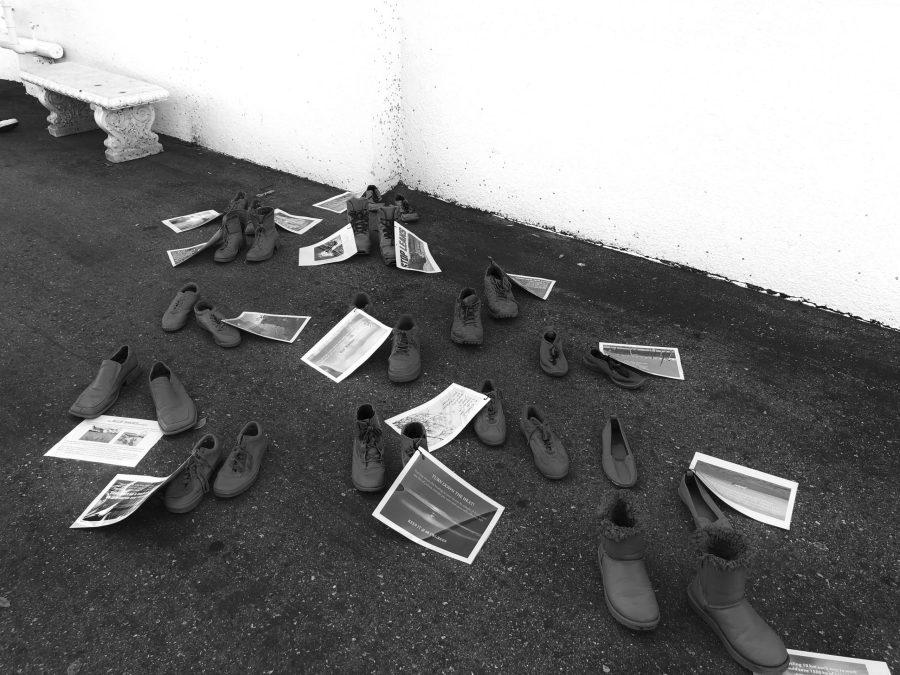Scattered across campus lay sets of blue shoes attached with posters painted and designed by the Advanced Photography and AP studio arts classes aiming to provide guidance on revamping environmental damage caused by climate change and human intercession.
Photography teacher Margo Wixsom said that the installment was a collaboration with Heidelberg professional artist Nicola Pragera.
“For Nicola Pragera, the shoes represented ‘Steps in the Water’ and the reality of rising sea levels,” Wixsom said. “Since he was the lead artist in this collaboration and we were invited to join the installation concept, my idea was to have blue shows represent the steps and missteps that we as humans take in making the world either a better or worse place.”
Pragera’s original installment displays hundreds of blue shoes placed in the centers of cities in Germany. Other cities that will be involved in the project include Stuttgart, Hamburg, Berlin, Barcelona and Amsterdam.
“The blue shoes show the future,” Pragera said. “They represent the water that will flood many coastal cities in the future due to climate change. The blue stands for water, and the shoes for people. This is where the name ‘Steps in the Water’ comes from.”
Pragera said that he currently has designed and painted 1000 pairs of blue shoes.
“The implementation of the project was not easy,” Pragera said. “First of all, I spent months collecting old shoes from friends and acquaintances. Then I made several attempts to find the best way to paint the shoes blue. It took me more than half a year to finish the first 100 pairs of shoes. Then I tried different arrangements (on) how the installation in the open air works best.”
Pragera said that he hopes to show the installation on the world-famous Piazza San Marco in Venice next autumn.
Paly photography classes extended Pragera’s concern regarding rising sea levels to all environmental issues.
“Photography students paired a set of shoes with a landscape photo and environmental fact so that the blue shoes also became a way to ‘display’ photographers connecting the image to the practices that we have in using land and resources,” Wixsom said.
Advanced Photography junior Ethan Hwang said the project was meant to address the issue of climate change in general.
“It intersected with our King Tides project, where we took pictures at high tide to draw attention to the rise of sea levels,” Hwang said.
Clipped onto each blue shoe is a poster designed by students expressing their personal suggestion for reducing the effects of climate change. Photography students chose to tackle various environmental issues such as ocean pollution, energy waste, food waste and extinction of species.
“My poster specifically discussed the high environmental cost of shipping food to supermarkets and other large retailers,” Hwang said. “I encouraged people to buy food from local farmers markets, as the food likely hasn’t traveled as far.”
On Hwang’s poster, he wrote, “Not only are fresh-picked fruits and vegetables tastier, they also help reduce the environmental impact from the transportation of food. On average, food from your local supermarket travels 1,500 miles before it reaches you. Think of all the pollution. Reduce your carbon footprint by buying local.”
Through this project, Wixsom hopes to create a nexus of art and advancement of eco-friendly methods.
“Modern photography can intersect and expand art disciplines — in this case paired with sculptural installations,” Wixsom said. “For the greater Paly community, I want them to better understand that literally every step we take each day in the choices that we make either helps or harms the planet. If better informed, I think people will transition to more sustainable ways of using resources and being in a healthy relationship with the planet that sustains us.”
Artists’ actions and messages, Pragera said, can be a powerful form of expression in which he hopes to create change.
“I hope that the project will make people think about the visual language of art,” Pragera said. “It should communicate a new form of demonstration and make the blue shoe a worldwide symbol of the environment and climate protection movement. ”

